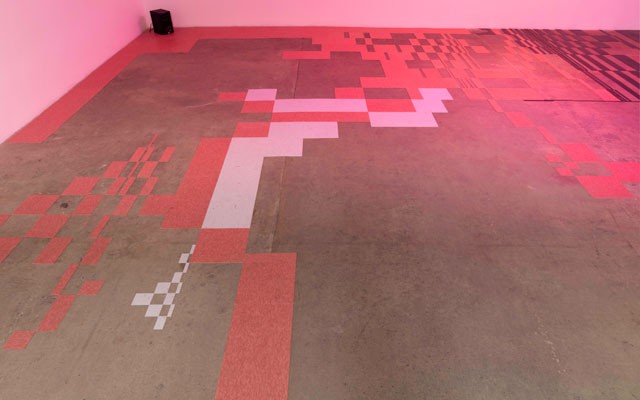Gigi’s Underground, Maggie Lee’s Los Angeles debut, is housed in the lower level gallery of 356 Mission. The space belongs to the titular Gigi, a teenage girl defined by her combative confessionalism and taste in early 2000s wannabe underground music. Through her habitual social media use, she obsessively maintains a hyper-constructed self-image; she is a suburban rebel in the solitude of her pink space.
A dusty pink light floods the otherwise untreated basement, illuminating sparsely hung cardboard hearts, stars, and flowers and re-collaged cut linoleum tile, a catchy contrast to the ceiling pipes. The hanging works represent her friends, pages taken straight from Gigi’s self-made zines. An old TV sits atop a storage rack at the center of the room connected to decorated headphones and mid-aughts art-pop. There are minimally framed origami works; something Lee herself has said signifies the mere ‘idea’ of an artwork, just as Gigi embodies a mere ’idea’ of a person.
This kind of diagrammatic work — narrative-rearing, art that situates a body — has a legacy of provisionality informed by histories of live, durational art. Performance art requires a live audience to be defined as such. Practitioners of performance art have applied the term to describe actions that occur in time and space, that develop a relationship between a performer and an observer. By this definition, performance includes work where a performer is absent, unsequestered by the very audience necessary to constitute the performance as such. A live audience observes a performer’s detritus and performance is born.
There is room in this quirky definition of performance for the following inquiry: What if sculpture addresses “liveness” sufficiently? What if an artist lays claim to an artistic model itself concerned with what exactly is so sculptural in the act of claiming space — thus birthing that unbridled constitutive performance, a more latent kind? The definition can be amended: A live audience observes the right kind of performer’s detritus and performance is born.
This is the case in Gigi’s Underground, which is distinctly performance and theater andsculpture. Historically speaking, drawing a line between performance and dramatic theater is difficult, contested widely by a distinction between entertainment and content-driven, conceptual work. But if there is an orienting point to work based in theater, it is inquiry about the body and its temporal qualities. The same goes for sculpture. I am not going to argue the fallibility of the distinction, which I find to be a fuzzy and cruel gesture, but I am interested in the quality of Lee’s work which traces re-enactment — a distinctly theatrical element — and why it matters.
If the traditional model of analyzing art-objects is to compose discrete objects into an affective idea, Gigi’s Underground asks for a search for personality, comprised of disparate elements that may belong to the girl herself. The exhibition decries the construction of autonomous art objects in order to better supplant the whole, in this case, the construction of (a very specific kind of) identity. If a suburban teenager curious about “making it” in the art-world is interesting subject matter, it is only interesting insofar as a fictitious character ignores audience expectations and re-enacts nonspecific ambiguity — and probably to many viewers — relatable identity. There is a script, you just can’t see it.
I remain, however, interested in this herself. This aversion to canonical object making in lieu of identity-formation is pleasantly tacit; in representing mere ideas (as opposed to the representation of an idea), Lee disembodies the material legacy of a work, replacing it with theatrical tableau, her own backdrop. This allows her to take the opportunity to reenact, to replace, to syncopate her narrative with a cultural one — indeed, she takes it wholeheartedly. And in foregrounding a project of reenactment with milieu, Lee is able to charm, astonishingly enough, with personhood. If works whose boundaries are clear, undisputable, all-encompassing belong to the white-cube, then lightweightness, desire, and the ahistorical belong to Gigi. The work is not a linear matter.
But as with most readymade tableaux and stage-sets, I am unconvinced by the reenactment. Nor is success here so defined by similitude – rather, the project of the work is to trouble time more. It begs the question: whose space is being represented, and why do they matter? Do they always? What does being forced to identify subcultures rather than objects say about an art economy all-too accustomed to identifying causal relationships among objects?
In melding a decentralized perspective with raw pleasure, Gigi’s Underground claims a kind of identity politics concerning itself with post-postmodernity and the personal/global via participating in the hedonistic pleasure of performance – a historically queer notion. Othering that responds to an overgrazed art economy with explicit theatricality is one way to reconfigure a relation. What does a show that pursues gooey emotive space over sublimity do? It remarks. Putting things together is no longer the render of causal relationships, but a consequence of narrative ones. This is the tool reenactment provides in the age of global capital: merge the sublime with real consequences and you may be closer to bread, not art.
Lee’s work is a solid display of lo-fi nostalgia and obscurity. To what end does a work like this and others hope to insinuate? Crossing back and forth and sideways along durational lines, lived experience and a represented one, (re)plays an idea of fruitful inadequacy. Intrigue lies here – in tableaux and failure, rather than in empirical statement. In the age of automation, one wonders what artistic approach is left to make lived history live again, producing a better kind of “memory industry”. Curatorial premises presenting narrativism melded with political theory rather than with citational asynchrony may be one option. If done successfully, such an approach implores us to consider: Can a reenactment be more real than an original situation?
